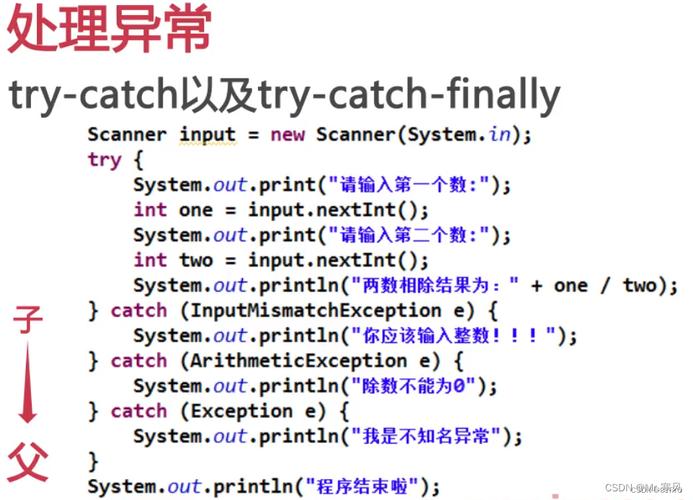finally报错分析与解决方案
在编程领域,finally 块通常与tryexcept 结构一起使用,用于确保无论是否发生异常,某些清理代码都能被执行,有时在使用finally 时可能会遇到一些错误或问题,本文将详细探讨finally 报错的可能原因、解决方法以及相关注意事项。

1.finally 块中的 return 语句
问题描述
如果在finally 块中使用了return 语句,它可能会导致预期之外的行为,因为finally 块中的return 会覆盖try 块中任何返回值。
示例代码
def example_function():
try:
return "Try block return"
finally:
return "Finally block return"
print(example_function()) # 输出:Finally block return解决方案
避免在finally 块中使用return 语句,如果需要在finally 块中返回结果,应考虑重构代码逻辑。

`finally` 块中的异常抛出
问题描述
如果在finally 块中抛出了一个异常,那么它会覆盖try 块中可能抛出的异常,导致调试困难。
示例代码
def example_function():
try:
raise ValueError("Error in try block")
finally:
raise KeyError("Error in finally block")
try:
print(example_function())
except Exception as e:
print(e) # 输出:'Error in finally block'解决方案
尽量避免在finally 块中抛出异常,如果有必须处理的逻辑,可以考虑将其放在try 块中或使用其他机制来记录和处理异常。
3.finally 块中的未处理异常

问题描述
如果在finally 块中发生了未处理的异常,它可能会掩盖try 块中的异常,导致难以诊断问题。
示例代码
def example_function():
try:
raise ValueError("Error in try block")
finally:
# 这里有一个拼写错误,应该是 print,但写成了 pritn
pritn("This will never be printed due to the typo.")
try:
print(example_function())
except Exception as e:
print(e) # 输出:'Error in try block'解决方案
确保finally 块中的代码没有语法错误或其他运行时错误,可以使用 IDE 或代码编辑器的语法检查功能来帮助发现这些错误。
4.finally 块中的资源释放问题
问题描述
finally 块常用于释放资源(如关闭文件、网络连接等),如果资源释放失败,可能会导致资源泄露或其他问题。
示例代码
def read_file(file_path):
file = open(file_path, 'r')
try:
data = file.read()
finally:
file.close() # close() 失败,可能会导致文件描述符泄露
return data解决方案
在关闭资源时捕获可能的异常,并记录日志以便后续分析。
def read_file(file_path):
file = open(file_path, 'r')
try:
data = file.read()
finally:
try:
file.close()
except Exception as e:
print(f"Failed to close file: {e}")
return data5.finally 块中的循环依赖问题
问题描述
在某些复杂的情况下,finally 块可能会依赖于try 块中的某些状态或结果,这可能导致逻辑上的混乱和错误。
示例代码
def complex_function():
result = None
try:
result = some_complex_operation()
finally:
if result is not None:
process_result(result)解决方案
尽量避免在finally 块中引入对try 块结果的依赖,可以通过将结果保存到变量中,并在finally 块外部处理这些结果。
def complex_function():
result = None
try:
result = some_complex_operation()
finally:
pass # No processing here
return result6.finally 块中的多线程问题
问题描述
在多线程环境中,如果多个线程共享同一个finally 块,可能会导致竞态条件和其他并发问题。
示例代码
import threading
def thread_safe_function():
try:
# Some threadspecific operations
finally:
# This finally block is shared across multiple threads
shared_resource.release()解决方案
确保finally 块中的逻辑是线程安全的,或者为每个线程提供独立的finally 块,可以使用线程锁或其他同步机制来保护共享资源。
lock = threading.Lock()
def thread_safe_function():
try:
# Some threadspecific operations
finally:
with lock:
# Safely release shared resource
shared_resource.release()7.finally 块中的递归调用问题
问题描述
在递归函数中,如果finally 块中再次调用了递归函数本身,可能会导致无限递归或栈溢出。
示例代码
def recursive_function(count):
try:
if count > 0:
recursive_function(count 1)
finally:
recursive_function(count 1) # Infinite recursion risk解决方案
避免在finally 块中进行递归调用,可以将递归逻辑封装在一个单独的函数中,并在需要时显式调用。
def recursive_function(count):
try:
if count > 0:
recursive_function(count 1)
finally:
pass # No recursive call here8.finally 块中的长时间运行操作
问题描述
如果finally 块中的操作非常耗时,可能会导致程序响应变慢或阻塞。
示例代码
def long_running_function():
try:
# Some quick operation
finally:
# Longrunning cleanup operation
time.sleep(10) # Simulate long running task解决方案
尽量将长时间运行的操作移到单独的线程或异步任务中执行,以避免阻塞主程序流程。
import threading
import time
def long_running_cleanup():
time.sleep(10) # Simulate long running task
def long_running_function():
try:
# Some quick operation
finally:
thread = threading.Thread(target=long_running_cleanup)
thread.start() # Start cleanup in a new thread9.finally 块中的 I/O 操作失败
问题描述
在finally 块中进行 I/O 操作(如写入日志文件)时,如果操作失败,可能会导致重要的调试信息丢失。
示例代码
def function_with_logging():
try:
# Some operations that might fail
finally:
try:
with open('log.txt', 'a') as log_file:
log_file.write("Operation completed
")
except Exception as e:
print(f"Failed to write to log file: {e}")解决方案
在finally 块中进行 I/O 操作时,始终捕获可能的异常并采取适当的恢复措施,如重试或记录到备用位置。
def function_with_logging():
try:
# Some operations that might fail
finally:
retries = 3
while retries > 0:
try:
with open('log.txt', 'a') as log_file:
log_file.write("Operation completed
")
break # Successful write, exit loop
except Exception as e:
retries = 1
if retries == 0:
print(f"Failed to write to log file after {3} attempts: {e}")10.finally 块中的资源竞争问题
问题描述
在多线程或多进程环境中,如果多个线程或进程同时访问共享资源,并且在finally 块中释放这些资源,可能会导致资源竞争和不一致的状态。
示例代码
shared_resource = []
def access_shared_resource():
try:
# Access shared resource
shared_resource.append(1)
finally:
# Release shared resource (potential race condition)
shared_resource.pop() if shared_resource else None解决方案
使用线程锁或其他同步机制来保护对共享资源的访问,确保在finally 块中安全地释放资源。
import threading
lock = threading.Lock()
shared_resource = []
def access_shared_resource():
try:
with lock:
# Access shared resource under lock protection
shared_resource.append(1)
finally:
with lock:
# Safely release shared resource under lock protection
if shared_resource:
shared_resource.pop()使用finally 块时需要小心谨慎,以确保其行为符合预期并且不会掩盖其他潜在的问题,通过遵循上述建议和最佳实践,可以有效地避免常见的finally 报错,并编写出更加健壮和可靠的代码。











